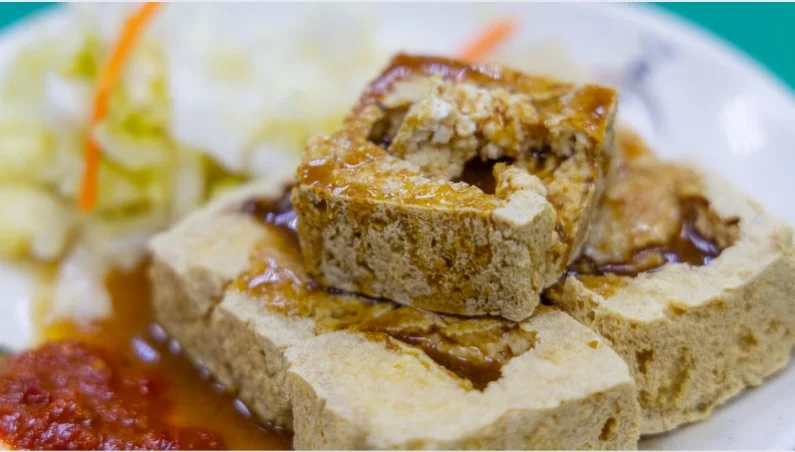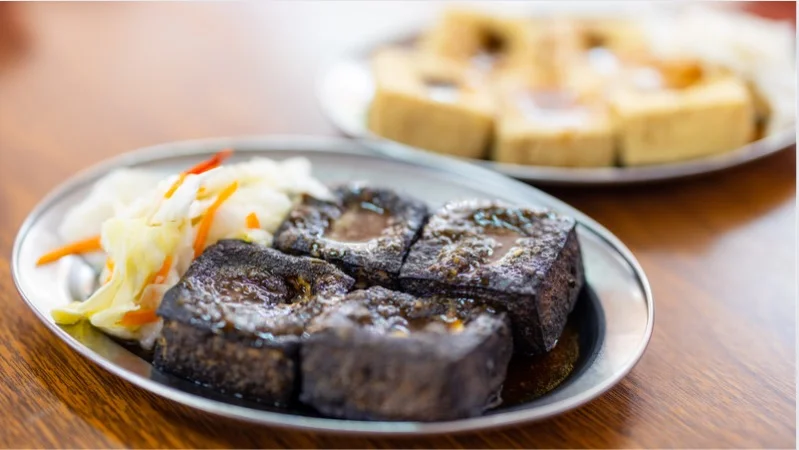Stinky tofu, a traditional Chinese dish known for its potent odor, has captivated food enthusiasts worldwide. This fermented tofu snack, often sold at night markets or roadside stands, is renowned for its unique preparation process and intense aroma. Despite its pungent smell, stinky tofu remains a beloved delicacy, deeply rooted in Chinese culinary traditions.
Origins and Cultural Significance
Stinky tofu, or “chòu dòufu” in Mandarin, has a long history dating back centuries. It is believed to have originated during the Qing Dynasty, becoming popular in the bustling streets of cities like Taipei, Hong Kong, and Shanghai. The dish’s strong aroma is a result of its fermentation process, which imparts a distinct flavor that is both complex and intriguing.
In Chinese culture, stinky tofu is more than just a snack; it represents a connection to tradition and local heritage. The dish is often enjoyed during festivals and special occasions, symbolizing community and shared experiences. Its preparation and consumption are seen as a testament to the ingenuity and creativity of Chinese cuisine.
The Fermentation Process
The hallmark of stinky tofu lies in its fermentation process. Unlike cheese, which has a standardized method for fermentation, stinky tofu varies widely in its preparation across regions and individual recipes. This variation contributes to the diversity of flavors and textures found in stinky tofu.
Traditional Fermentation
Traditionally, stinky tofu is fermented in a brine made from a combination of fermented milk, vegetables, and meat. The brine can also include ingredients such as dried shrimp, amaranth greens, mustard greens, bamboo shoots, and Chinese herbs. This mixture creates a rich and flavorful environment for the tofu to absorb.
The fermentation process can take several months, allowing the tofu to develop its characteristic strong odor and deep flavor. During this time, the tofu undergoes a transformation, with the brine breaking down its proteins and fats, resulting in a soft and creamy texture. The longer the fermentation, the more intense the flavor and aroma.
Modern Production Methods
In modern factory settings, the production of stinky tofu has been streamlined to meet commercial demands. Instead of fermenting for months, factory-produced stinky tofu is marinated in brine for one or two days. This accelerated process still imparts the signature odor, though it may lack the depth of flavor achieved through traditional methods.
Despite the shorter fermentation period, modern stinky tofu retains its appeal. The brine used in factory production often includes a carefully selected blend of ingredients to replicate the complex flavors of traditional stinky tofu. This approach ensures that the dish remains accessible to a broader audience while maintaining its distinctive characteristics.

Regional Variations
This exhibits significant regional variations in its preparation and presentation. These differences highlight the adaptability of the dish and its ability to reflect local tastes and preferences.
Taiwan
In Taiwan, stinky tofu is a ubiquitous street food, often deep-fried and served with pickled cabbage and a spicy sauce. The tofu cubes are crispy on the outside and soft on the inside, offering a delightful contrast in textures. Taiwanese tofu is known for its milder odor compared to other regions, making it more approachable for those new to the dish.
Hong Kong
Hong Kong-style stinky tofu is typically served grilled or fried, accompanied by a variety of dipping sauces. The tofu is marinated in a brine containing a mix of seafood and vegetables, resulting in a robust flavor profile. In Hong Kong, this is a popular snack during street festivals and night markets, where its strong aroma draws curious food lovers.
Mainland China
In Mainland China, stinky tofu can vary widely from region to region. In Hunan province, for example, it is often fermented for a longer period, resulting in a more intense smell and flavor. It is commonly served with a spicy chili sauce, adding a fiery kick to the already bold dish. In contrast, Shanghai-style stinky tofu is usually milder and served with sweet soy sauce and pickled vegetables.
Culinary Uses and Serving Suggestions
This is versatile in its culinary applications, enjoyed as a snack, side dish, or even incorporated into main dishes. Its strong flavor pairs well with various accompaniments, enhancing the overall dining experience.
As a Snack
As a snack, stinky tofu is often enjoyed on its own or with simple condiments. Deep-fried stinky tofu, with its crispy exterior and creamy interior, is a favorite among street food enthusiasts. It is commonly served with a side of pickled cabbage, which adds a refreshing tang to balance the richness of the tofu.
As a Side Dish
In lunch bars and casual dining establishments, stinky tofu is frequently served as a side dish. It can be steamed, grilled, or braised, depending on the regional style. When served as a side, this complements a variety of main dishes, from rice and noodles to stir-fried vegetables and meats.
In Main Dishes
Innovative chefs have also found ways to incorporate stinky tofu into main dishes, creating fusion recipes that showcase its unique qualities. For example, stinky tofu can be added to hot pots, where it absorbs the flavors of the broth while contributing its distinctive aroma. It can also be used in stir-fries, providing a bold contrast to fresh vegetables and savory sauces.
Health Benefits and Nutritional Value
Stinky tofu, like other fermented foods, offers several health benefits. The fermentation process enhances the nutritional profile of tofu, increasing its content of beneficial probiotics. These probiotics support gut health, aiding digestion and boosting the immune system.
Additionally, it is a good source of protein, making it a valuable addition to vegetarian and vegan diets. It also contains essential vitamins and minerals, such as calcium, iron, and magnesium. Despite its strong smell, stinky tofu is a nutritious and wholesome food that can contribute to a balanced diet.
Conclusion
Stinky tofu, with its strong odor and unique flavor, remains a beloved delicacy in Chinese cuisine. Its traditional fermentation process, diverse regional variations, and versatile culinary applications make it a fascinating and cherished dish. Whether enjoyed as a snack, side dish, or part of a main course, stinky tofu continues to captivate food enthusiasts with its bold and unforgettable taste.









